If Florida was a pancake, the Keys would be a gigantic dribble of batter dripped off its southern tip, curving into a last divider between gulf and ocean. Southeast of Miami, the shore and sea mingle in the Everglades to the point they can be hard to distinguish from one another.
Is two days enough to explore keys and glades? Two significantly different ecosystems? Of course not. But, if two days is all you have, here’s how some friends and I dove in.
Day 1: Everglades National Park.
The first surprise was finding one of the largest National Parks in the U.S. only a 45-minute drive from the Miami airport. Happy to move beyond the sprawl of the city, we easily made our way to the Edward Coe Visitor’s Center. Note, you’re not in the park yet, but there is an informative display, restrooms and a gift shop. At the Park Entrance Station a few hundred feet down the road, we discovered the advantage of having someone in the party who qualified for the Senior annual pass (available to anyone at least 65). For $20.00, the pass-holder may visit every single National Park in the U.S. as many times as they want, for a year.
Well sunscreened and equipped with maps and water bottles, we ventured the four miles past the park entrance to Royal Palm. There the Anhinga Trail enticed us across a section of freshwater marsh called the Taylor Slough (pronounced sloo). A fit person could bounce over that boardwalk in less than thirty minutes, but why?
Not five minutes into the adventure, we spied baby alligators cruising in a channel of warm shallow water. Less than two feet long, they were probably less than a year old. Twenty feet further along, a mature alligator (perhaps the mother?) rose to the surface of the slough and breached through the lilies. We all jumped. No one questioned who was in charge. The water was dark in color, but clear enough to see turtles, Florida gar, catfish and many fish and plant species I couldn’t name.
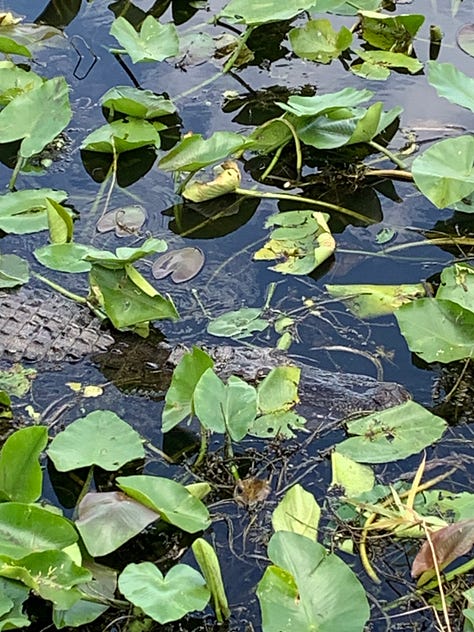
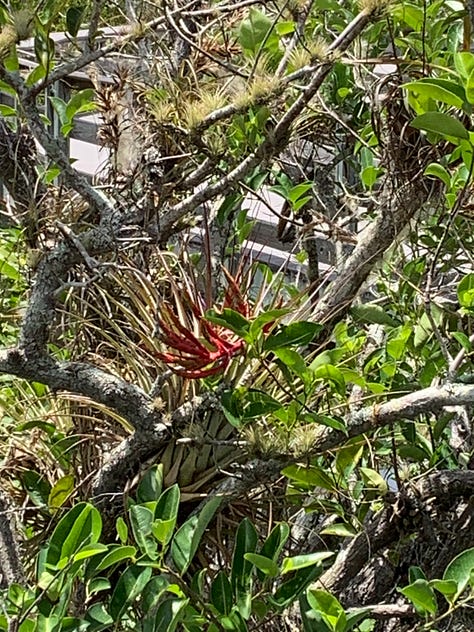
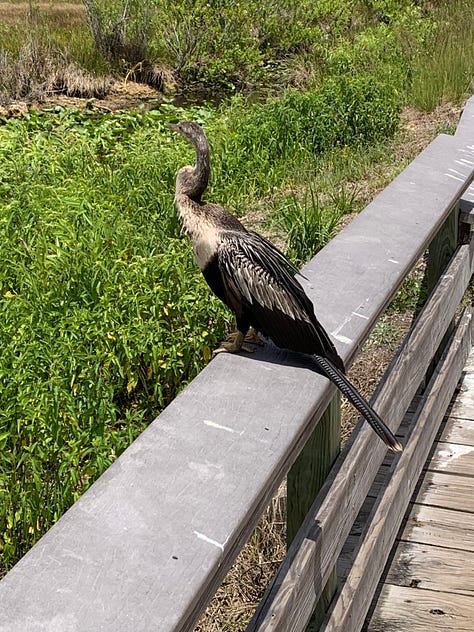
The Anhinga Trail takes its name from a strikingly plumaged waterbird whose spear-like beak equips it to fish. We saw several sitting with wings outstretched to dry, and even came across one in conflict with a large Wood stork.
As we meandered through sawgrass and trees festooned with bromeliads (symbiotic plants sometimes known as “air plants”) shaded stopping points provided welcome respite from the sun. I didn’t see anyone using strollers or wheelchairs, but imagine they would easily roll across the boardwalk.
Before taking on the next trail (Gumbo Limbo) we dropped in on a brief discussion with Ranger Dave. We welcomed the shade, information and interaction with other visitors in Royal Palm’s breezy outdoor classroom space. He explained the difference between the American alligator and crocodile (both local inhabitants) and provided insight on the problem of invasive species, especially the Burmese python population, “…which is why you don’t see mammals around here anymore.” No more racoons, squirrels, bobcats, rats or river otters. The pythons swim, climb trees and are highly prolific.
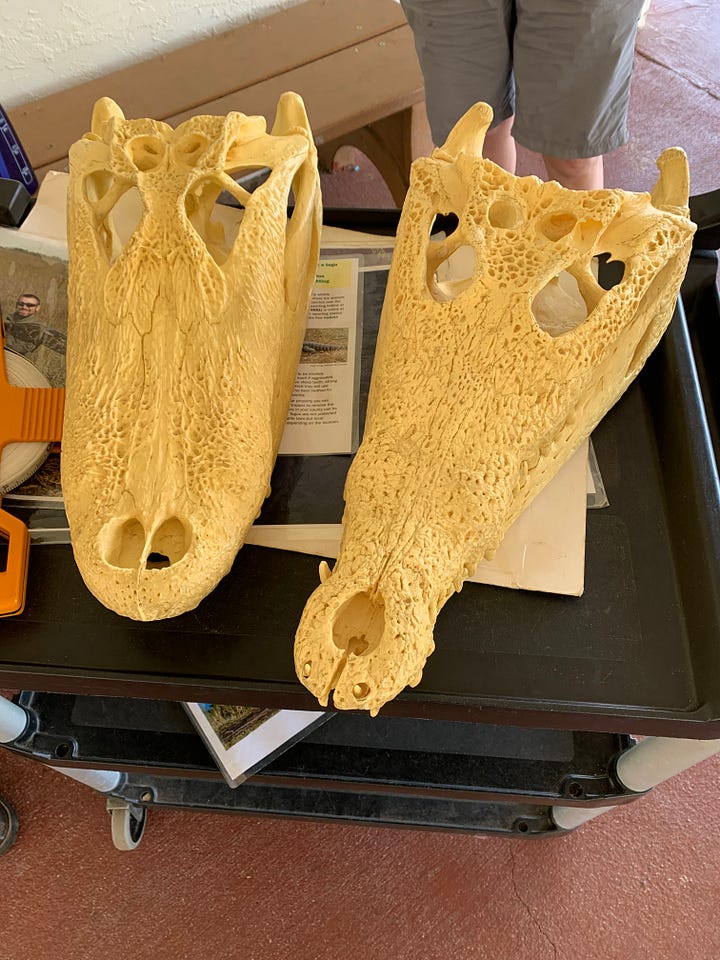
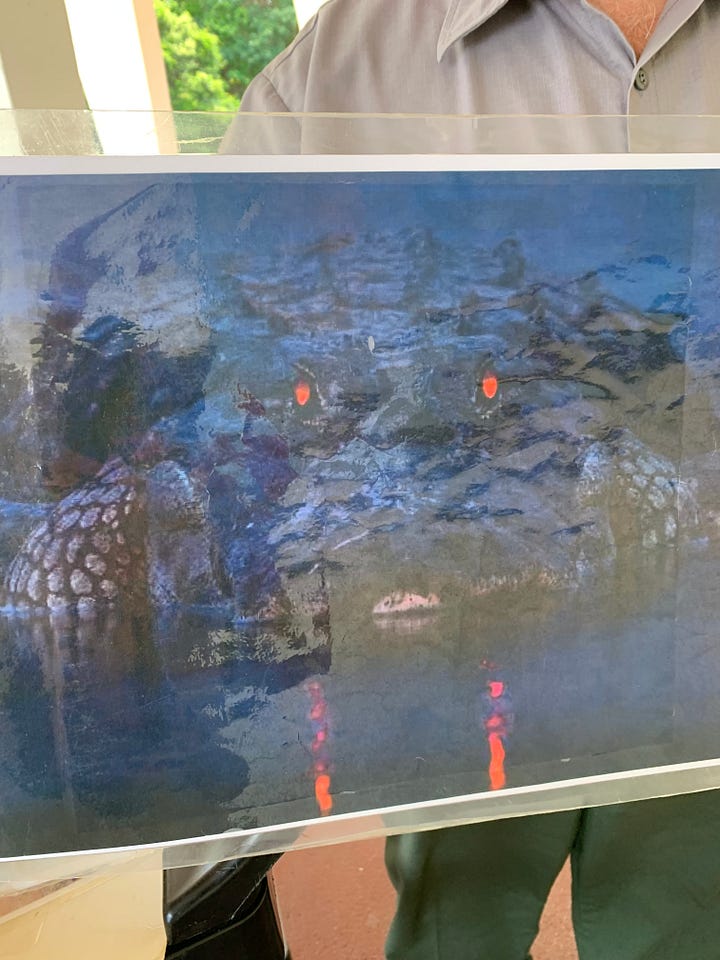
This information gave us a bit of pause as we headed off to the shady Gumbo Limbo trail, named for a red-skinned tree with flaky bark (which has also earned it some nicknames such as “tourist tree”).
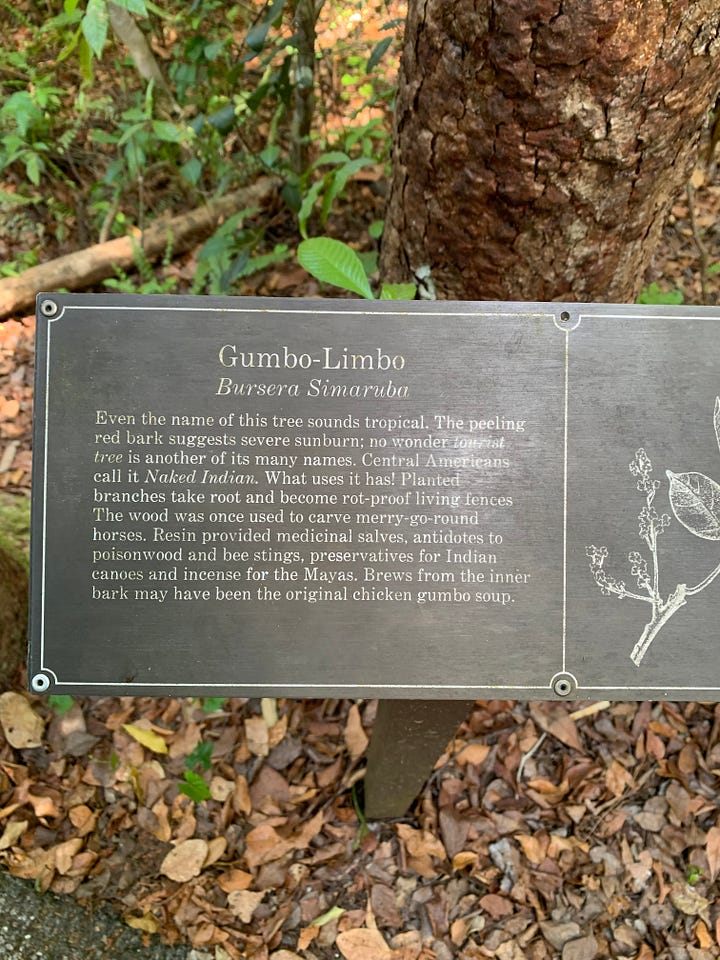
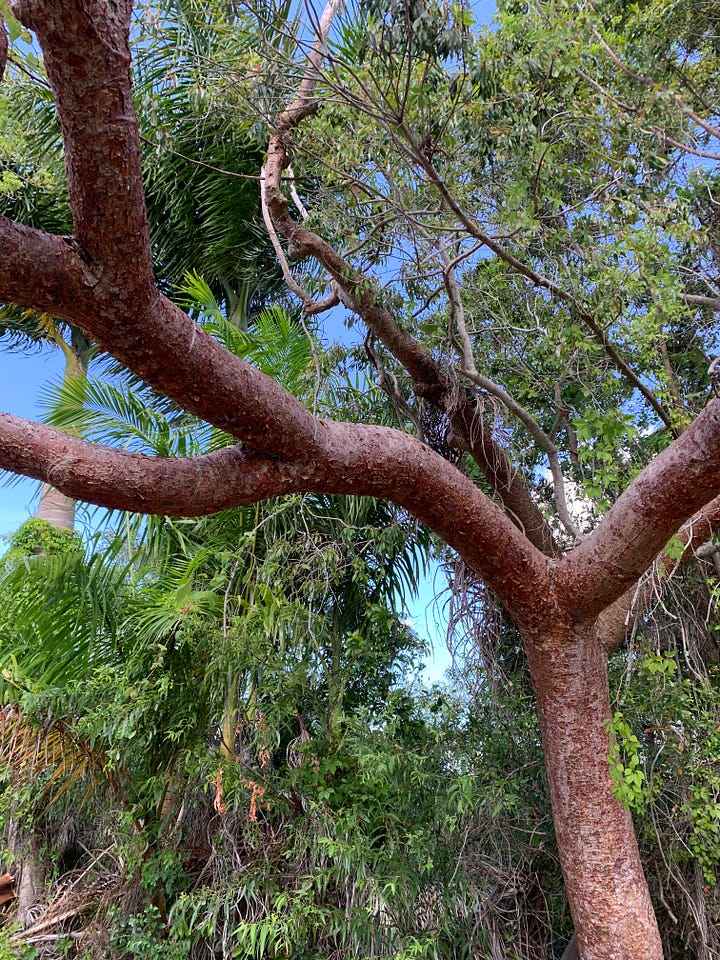
To my knowledge no pythons slithered along. The trail led through what is known as a hardwood hammock, or tropical forest. Gumbo Limbo, live oak, magnolias, hackberries and all their cousins interlaced limbs and leaves creating a canopy above and a chapel-like atmosphere below. Strangler figs sculpted themselves around mighty trunks. Here and there, trees upturned by Hurricane Andrew more than thirty years ago, created alcoves revealing the mysteries of root systems that thrive in shallow soil. A few butterflies graced our way.
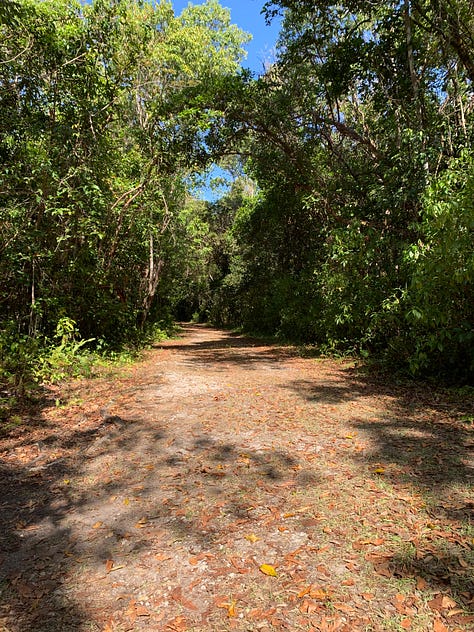
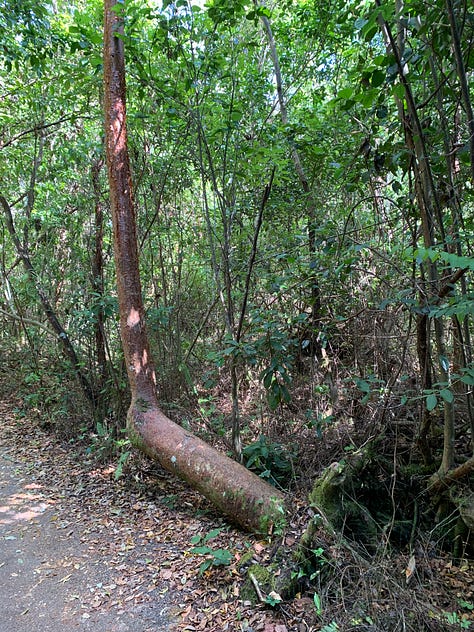
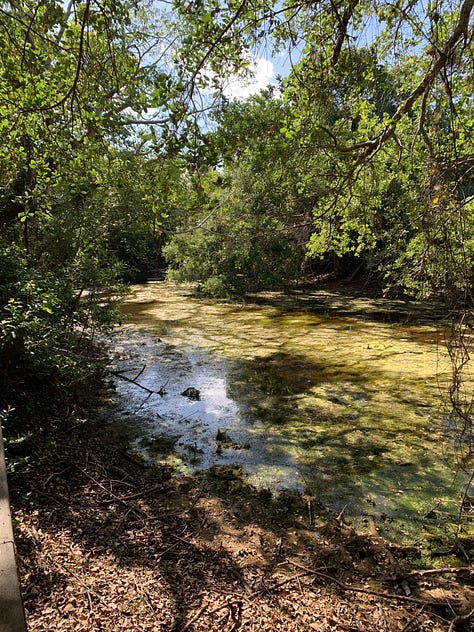
The Gumbo Limbo trail was not long, but sufficient to provide a sense of the quiet terrestrial side of the Everglades. At a moderate pace, with plenty of stops to take in nuances, we completed the trail in less than 45 minutes.
One day was enough to whet appetites to return to the Everglades where a great deal more exploration awaits.
Day 2: Biscayne National Park
Practically next door to the Everglades, a much less well-known national park stretches across the Bay of Biscayne. We enjoyed a boardwalk and easy trail through the mangroves before approaching the Dante Fascell visitor center, a bayside retreat flanked with wide verandas and rocking chairs. I easily imagined spending a whole day surrounded by ocean air and view and maybe a paperback.

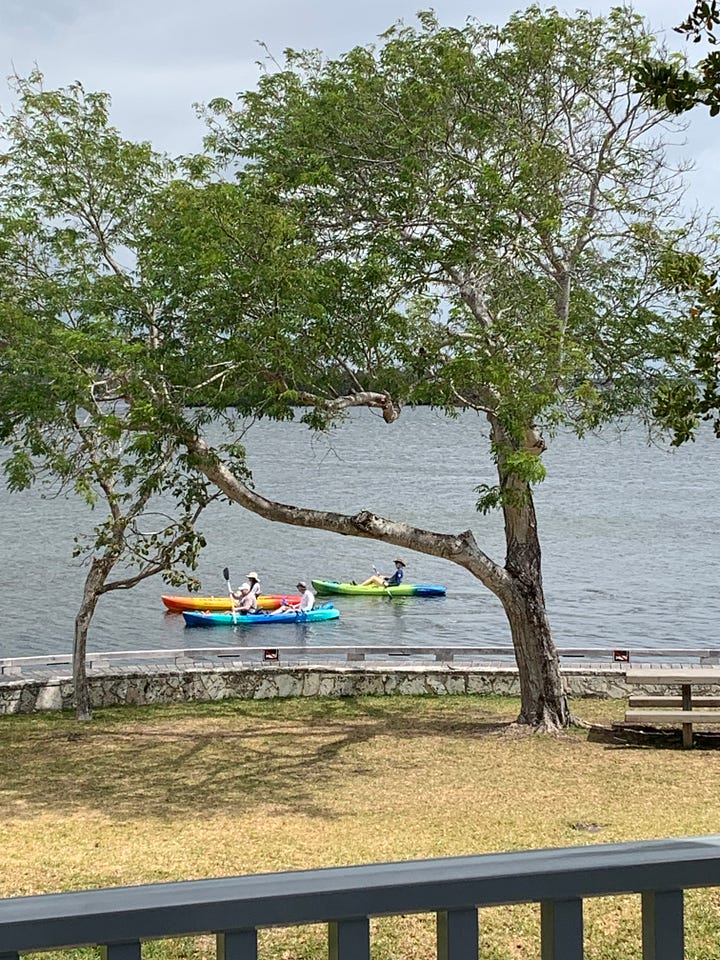
Instead, we discovered a boat tour. We boarded the Stingray sightseeing vessel, manned by Captains B.J. and Jess, and along with twenty other guests, skimmed across the bay toward Boca Chita Key in search of dolphins, maybe a manatee and the sheer joy of fresh ocean spray.
Our captains took turns sharing local and natural history. Fringed by the keys, the bay is no more than 6 to 8 feet deep, and covers 221 square miles of nutrient-rich waters. Mangroves once edged the majority of Florida coastlines, but many were removed to create tourist-friendly beaches. Protected in the Bay of Biscayne, mangroves provide a natural barrier against hurricane damage. They also serve as nursery for many fish species. It was easy to see why as we cruised past tangled root systems, above and below the surface. The three types of mangroves: Red, White and Black, can be identified by their root characteristics, but all share the ability to thrive in fresh or saltwater.
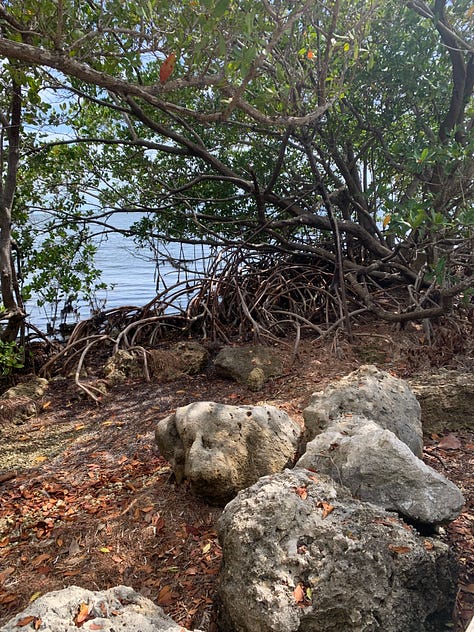
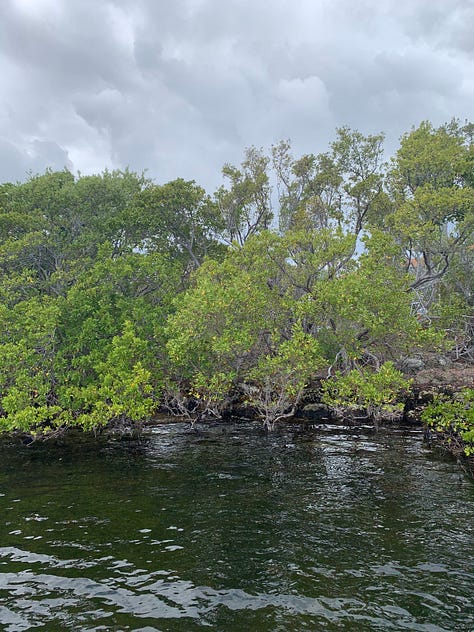
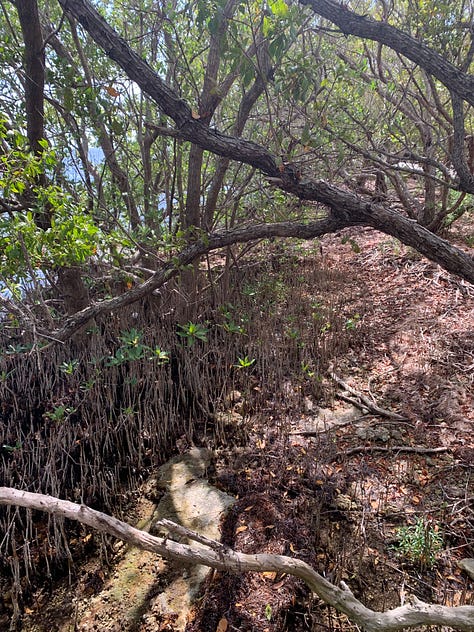
Boca Chita is one of thirteen hundred(ish) keys off the south coast of Florida formed from colonies of coral that exposed to air over time attracted vegetation. Some are just big enough to support a couple of mangrove trees. Many are far larger and well-known such as Key Largo and Key West.
Visiting by boat was a wonderful way to encounter this ecosystem. Carpeted in sea-grass, the bay reflected sunlight in a thousand shades of jade and turquoise. Our craft was small and quiet enough to creep into a lagoon where manatees play. “Look for a big floating potato,” said Captain Jess. We didn’t, but someday I will.
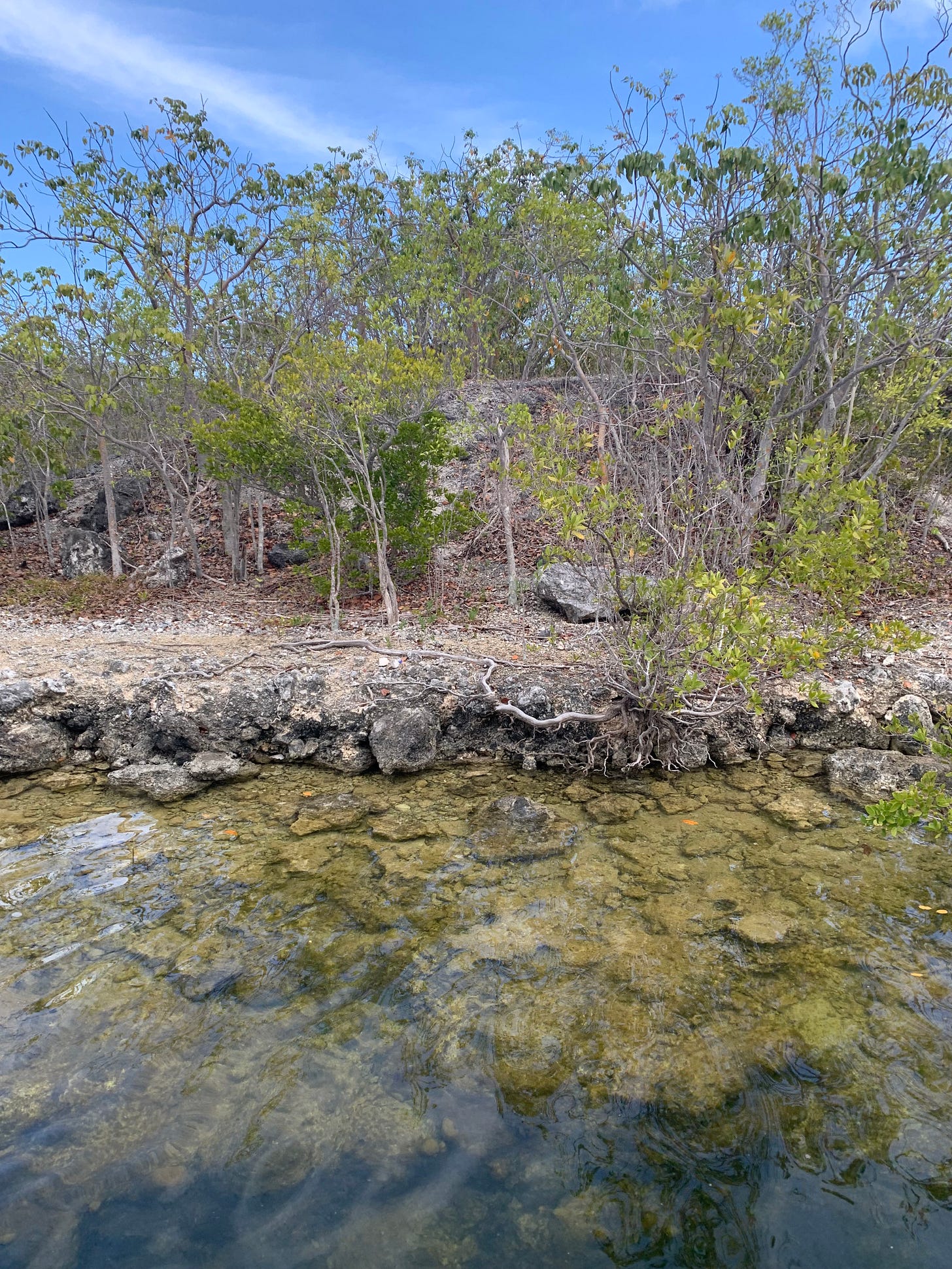
A little later, we docked at Boca Chita Key, former playground of Jazz Age millionaires and spent time enjoying their private beach. Back in the day, orchestras and even Rosie the elephant were barged over from Miami. What’s a party without a good dance band? And a pachyderm?
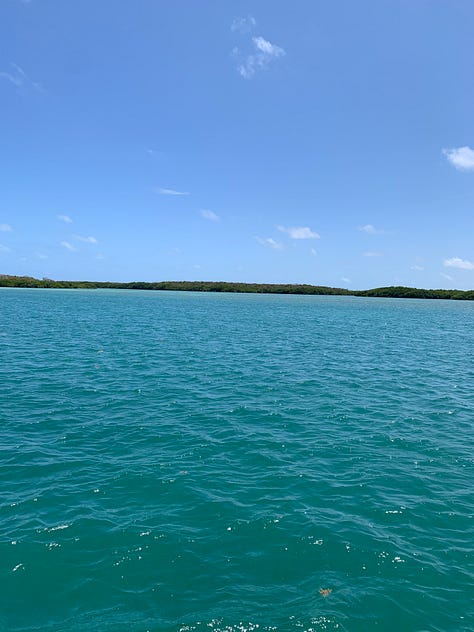
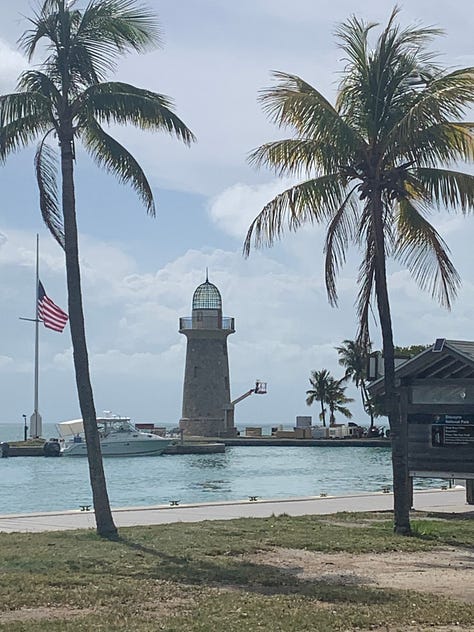
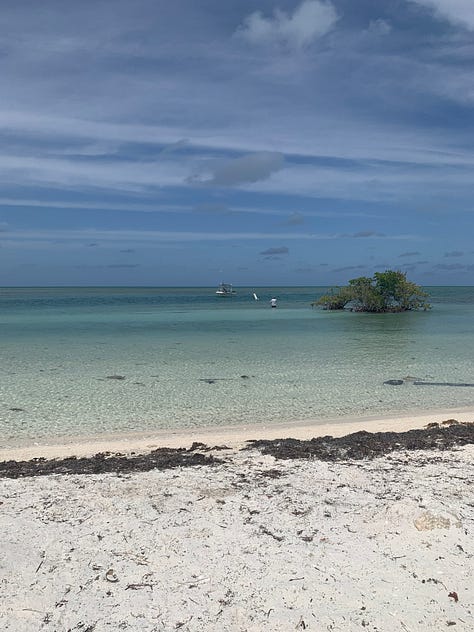
Full of fresh ocean air and new knowledge, as we docked back at the Visitor Center, I made note of yet another place in the world where a person could spend a peaceful afternoon or two… or maybe a month by the sea.
These two days of adventure took place during the first weekend of May. The weather was sublime with temperatures in the mid-seventies and eighties and sunny but not sultry. In my home state of Kentucky, a horse named Sovereignty won the Derby. Instead of sipping mint juleps, we feasted on chocolate chip mint ice cream, and enjoyed the evening breezes.
Praises
The opportunity to explore new places opens doors in many ways — praise God for his providence and beautiful creation!
Mothers! Praise God, and happy Mother’s day to all who nurture others.
Some pregnancies we’ve prayed for have gone full term and two new baby girls (cousins) have arrived—healthy and beautiful! Praise God for his blessing!
Watching a group of children play outdoors yesterday evening— screen-free— was a huge blessing. What a throwback. Thank you God for this reminder!
A woman celebrates two years of being cancer-free! Praise God!
Prayers
A family mourns the loss of their brother/son/husband to pancreatic cancer. He was not quite sixty.
A man prepares to travel with his son to visit his elderly father. Lord God, we ask for your blessing on this three-generation endeavor. Pour out your love and mercy in a mighty way.
A young couple plan to marry this month. She has been diagnosed with a rare form of lung cancer, but they are optimistic for healing and for their future together. Lord God, we agree in prayer for your blessing upon them.
A young man’s parents are ready for him to step up and get a job. Lord, you know the situation. Please provide encouragement all the way around.
Quests
In the 1960’s developers who created the Miami beach mecca cast an eye on the Bay of Biscayne. They began buying up keys. One son of homesteaders, Lancelot Jones, stood firm and refused multiple multi-million dollar offers. He had grown up on and in the bay and would not play party to their plan to dredge a deep shipping channel. Lancelot was instrumental in the designation of the bay as a national monument, and eventually a national park. Influential in an era when people of his race were fighting for their civil rights, Jones was the son of a man born into slavery.
Following in their parent’s footsteps, Lancelot Jones and his brothers farmed pineapples and key limes. After hurricane damage and competition from lower priced production out of Mexico forced them to look for new revenue streams, the farmer became a fishing guide for wealthy visitors, including three U.S. presidents. In his later years, Jones moved to Miami where he remained active in the community, including Mount Zion Baptist Church, until he passed away at the age of 99.
May all those who serve in the preservation of God’s creation be brave and encouraged. Hug a park ranger today!
Until next week,
Wherever you are, whatever is going on, may you sense God’s amazing love for you.
“Forget the former things; do not dwell on the past. See I am doing a new thing! Now it springs up; do you not perceive it? I am making a way in the desert and streams in the wasteland.” Isaiah 43:18-19
With love,
Jana




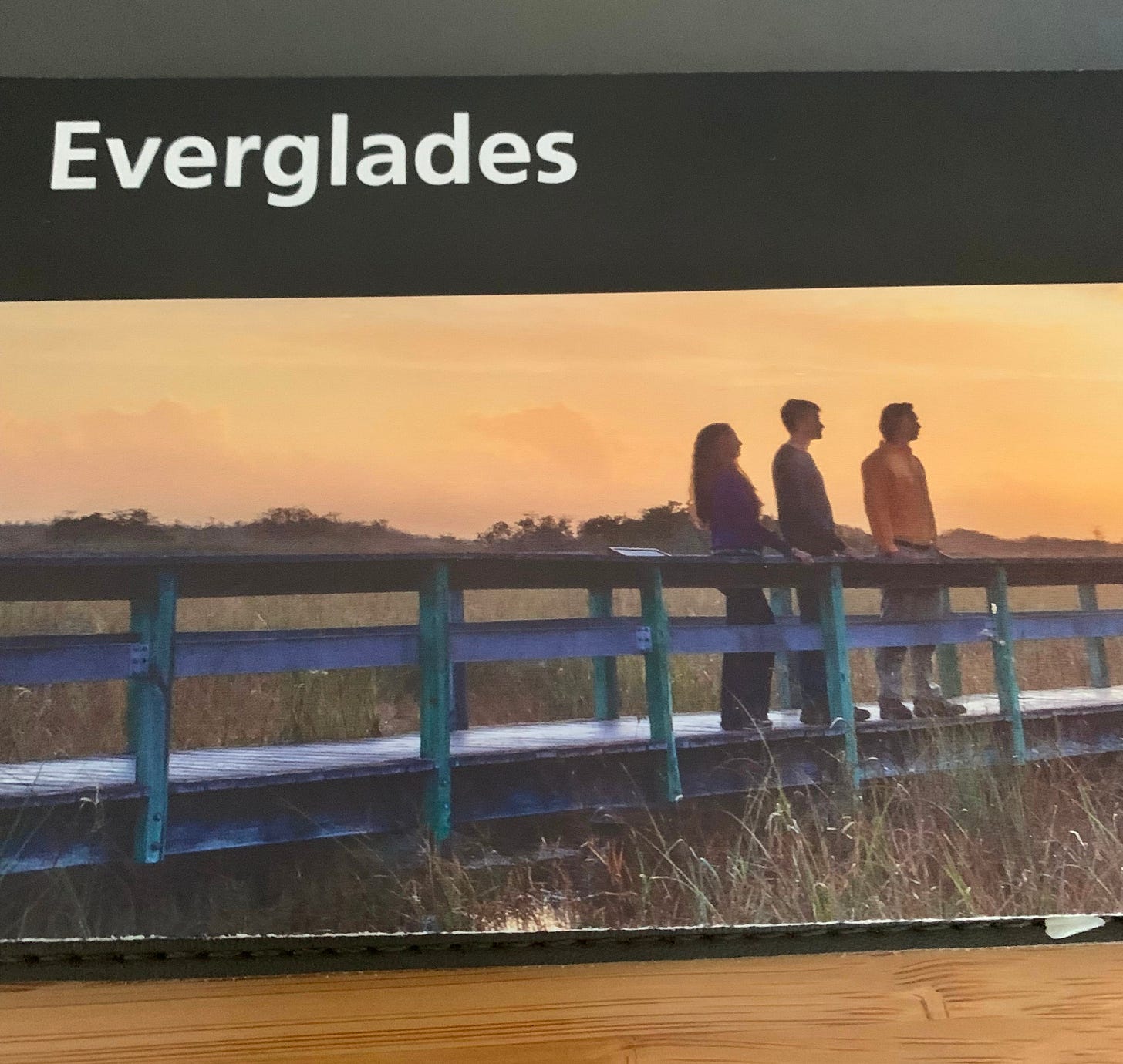
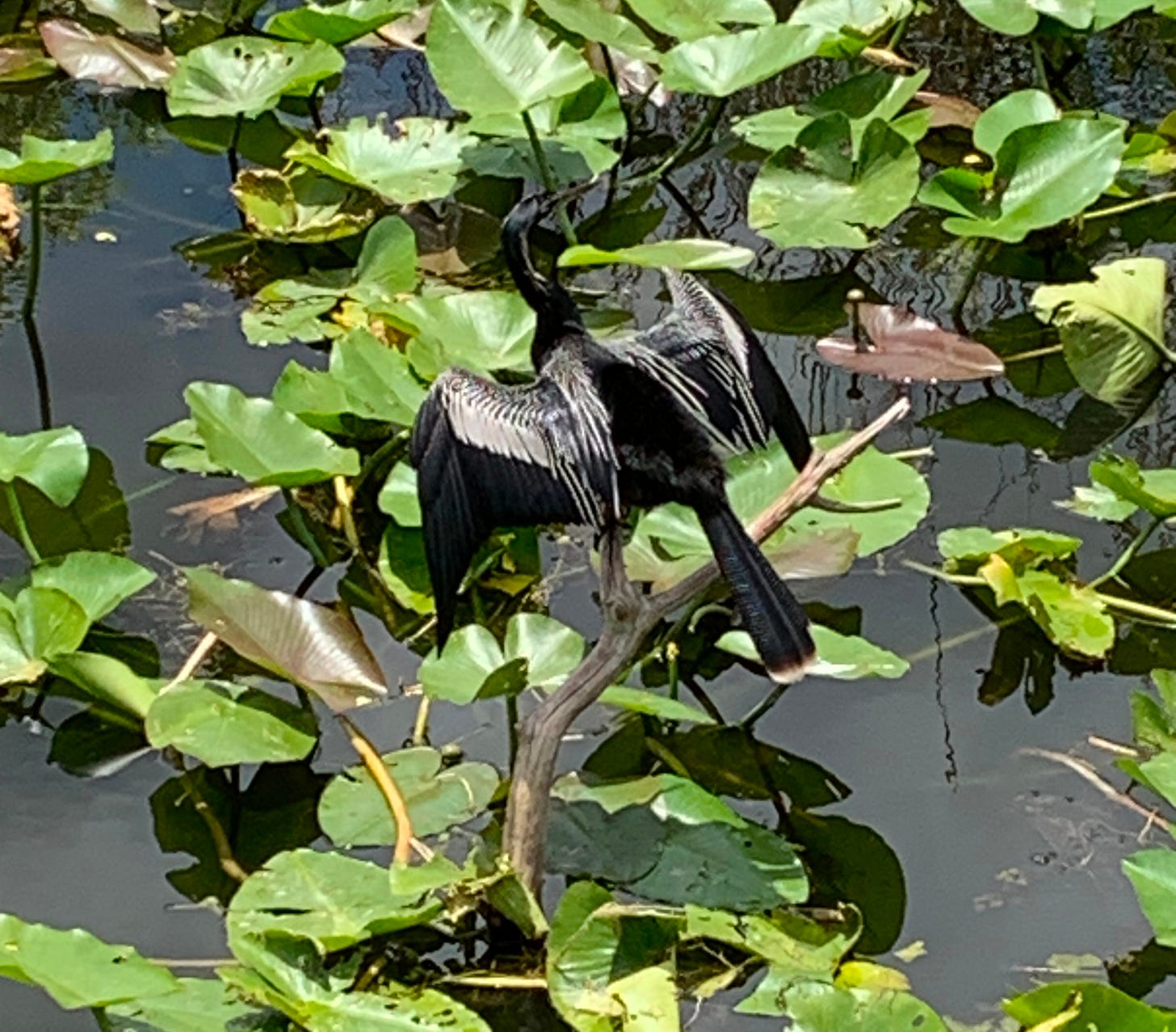

Love this virtual tour❤️and the reminder of hope for new things!
What a wonderful record of our trip! Thank you for writing this!